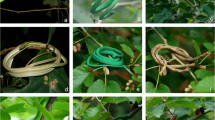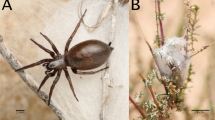Abstract
Communal predators may often need to make especially intricate foraging decisions, as a predator’s success may depend on the actions of its neighbours. Here, we consider the decisions made by Portia africana, a jumping spider (Salticidae) that preys on other spiders, including Oecobius amboseli (Oecobiidae), a small prey spider that lives under small sheets of silk (nests) on the walls of buildings. P. africana juveniles settle near oecobiid nests and then ambush oecobiids as they leave or enter the nest. Two or more P. africana juveniles sometimes settle at the same nest and, when an oecobiid is captured, the P. africana juveniles may share the meal. We investigated the joining decisions made by naïve P. africana juveniles. Experiments were based on using lures (dead spiders positioned in lifelike posture) arranged in a series of 17 different scenes defined by the presence/absence of a nest, the lure types present and the configuration of the lures and the nest. Our findings imply that P. africana juveniles make remarkably precise predatory decisions, with the variables that matter including whether a nest is present, the identity of spiders inside and outside a nest and how spiders are positioned relative to each other and the nest.


Similar content being viewed by others

References
Abbott KR, Dukas R (2009) Honeybees consider flower danger in their waggle dance. Anim Behav 78:633–635
Amir N, Whitehouse MEA, Lubin Y (2000) Food consumption rates and competition in a communally feeding social spider, Stegodyphus dumicola (Eresidae). J Arachnol 28:195–200
Beutel RG, Pohl H, Hunefeld F (2005) Strepsipteran brains and effects of miniaturization (insecta). Arthropod Struct Dev 34:301–313
Brodie ED III, Brodie ED Jr (1999) Predator–prey arms races. Bioscience 49:557–568
Brown JS, Kotler BP (2004) Hazardous duty pay and the foraging cost of predation. Ecol Lett 7:999–1014
Cerveira AM, Jackson RR (2011) Interpopulation variation in oecobiid-specific prey-capture behaviour and kairomone use by Cyrba algerina, an araneophagic jumping spider from Portugal. J Ethol 29:121–129
Chittka L, Niven J (2009) Are bigger brains better? Curr Biol 19:R995–R1008
Curio E (1976) Ethology of predation. Springer, Berlin
Dall SRX, Giraldeau L-A, Olsson O, McNamara JM, Stephens DW (2005) Information and its use by animals in evolutionary ecology. Trends Ecol Evol 20:187–193
Donadio E, Buskirk SW (2006) Diet, morphology, and interspecific killing in Carnivora. Am Nat 167:524–536
Eberhard WG (2007) Miniaturized orb-weaving spiders: behavioural precision is not limited by small size. Proc R Soc (B) 274:2203–2209
Eberhard WG (2011) Are smaller animals behaviourally limited? Lack of clear constraints in miniature spiders. Anim Behav 81:813–823
Ewert JP (2004) Motion perception shapes the visual world of amphibians. In: Prete FR (ed) Complex worlds from simpler nervous systems. MIT Press, Cambridge, pp 117–160
Glatz L (1967) Zur Biologie und Morphologie von Oecobius annulipes Lucas (Araneae, Oecobiidae). Z Morph Tiere 61:185–214
Guseinov EF, Cerveira AM, Jackson RR (2004) The predatory strategy, natural diet and life cycle of Cyrba algerina, an araneophagic jumping spider (Salticidae: Spartaeinae) from Azerbaijan. N Z J Zool 31:291–303
Harland DP, Jackson RR (2001) Prey classification by Portia fimbriata, a salticid spider that specializes at preying on other salticids: species that elicit cryptic stalking. J Zool 255:445–460
Harland DP, Jackson RR (2004) Portia perceptions: the umwelt of an araneophagic jumping spider. In: Prete FR (ed) Complex worlds from simpler nervous systems. MIT Press, Cambridge, pp 5–40
Harland DP, Jackson RR, Macnab AM (1999) Distances at which jumping spiders (Araneae: Salticidae) distinguish between prey and conspecific rivals. J Zool 247:357–364
Herberstein ME, Wignall A (2011) Deceptive signals in spiders. In: Herberstein ME (ed) Spider behaviour: flexibility and versatility. Cambridge University Press, New York, pp 190–214
Holt RD, Polis GA (1997) A theoretical framework for intraguild predation. Am Nat 149:745–764
Jackson RR (1979) Predatory behavior of the social spider Mallos gregalis: is it cooperative? Insectes Soc 26:300–312
Jackson RR, Pollard SD (1996) Predatory behavior of jumping spiders. Ann Rev Entomol 41:287–308
Jackson RR, Wilcox RS (1998) Spider-eating spiders. Am Sci 86:350–357
Jackson RR, Pollard SD, Li D, Fijn N (2002) Interpopulation variation in the risk-related decisions of Portia labiata, an araneophagic jumping spider (Araneae, Salticidae), during predatory sequences with spitting spiders. Anim Cogn 5:215–223
Jackson RR, Pollard SD, Salm K (2008) Observations of Portia africana, an araneophagic jumping spider, living together and sharing prey. N Z J Zool 35:237–242
Jakob EM, Christa D, Skow CD, Long S (2011) Plasticity, learning and cognition. In: Herberstein ME (ed) Spider behaviour: flexibility and versatility. Cambridge University Press, New York, pp 307–347
Kim K, Krafft B, Choe J (2005) Cooperative prey capture by young subsocial spiders: II. Behavioral mechanism. Behav Ecol Sociobiol 59:101–107
Land MF (1974) A comparison of the visual behaviour of a predatory arthropod with that of a mammal. In: Wiersma CAG (ed) Invertebrate neurons and behavior. MIT Press, Cambridge, pp 411–418
Land MF, Nilsson DE (2002) Animal eyes. Oxford University Press, Oxford
Lettvin JY, Maturana HR, McCulloch WS, Pitts WH (1959) What the frog’s eye tells the frog’s brain. PIRE 47:1940–1951
Li D, Jackson RR (1996) Prey preferences of Portia fimbriata, an araneophagic, web-building jumping spider (Araneae: Salticidae) from Queensland. J Insect Behav 9:613–642
Lima SL, Dill LM (1990) Behavioral decision making under the risk of predation: a review and prospectus. Can J Zool 68:619–640
Mukherjee S, Zelcer M, Kotler BP (2009) Patch use in time and space for a meso-predator in a risky world. Oecologia 159:661–668
Nelson XJ, Jackson RR (2006) A predator from East Africa that chooses malaria vectors as preferred prey. PLoS ONE 1:e132. doi:10.1371/journal.pone.0000132
Nelson XJ, Jackson RR (2011) Flexibility in the foraging strategies of spiders. In: Herberstein ME (ed) Spider behaviour: flexibility and versatility. Cambridge University Press, New York, pp 31–56
Nieh JC (2010) A negative feedback signal that is triggered by peril curbs honey bee recruitment. Curr Biol 20:310–315
Packer C, Ruttan L (1988) The evolution of cooperative hunting. Am Nat 132:159–192
Polis GA, Holt RD (1992) Intraguild predation: the dynamics of complex trophic interactions. Trends Ecol Evol 7:51–154
Salomon M (2007) Western black widow spiders express state-dependent web-building strategies tailored to the presence of neighbours. Anim Behav 73:865–875
Salomon M (2009) Social environment and feeding state influence movement decisions in a web-building spider. Ethology 115:916–927
Sih A (1980) Optimal behavior: can foraging balance two conflicting demands? Science 210:1041–1043
Srinivasan MV (2010) Honey bees as a model for vision, perception, and cognition. Ann Rev Entomol 55:267–284
Temple SA (1987) Do predator always capture substandard individuals disproportionately from prey populations? Ecology 68:669–674
Vanacker D, Deroose K, Pardo S, Bonte D, Maelfait JP (2004) Cannibalism and prey sharing among juveniles of the spider Oedothorax gibbosus (Blackwall, 1841) (Erigoninae, Linyphiidae, Araneae). Belg J Zool 134:23–28
Wachowitz S, Ewert JP (1996) A key by which the toad’s visual system gets access to the domain of prey. Physiol Behav 60:877–887
Whitehouse MEA, Jackson RR (1998) Predatory behaviour and parental care in Argyrodes flavipes, a social spider from Queensland. J Zool 244:95–105
Williams DS, McIntyre P (1980) The principal eyes of a jumping spider have a telephoto component. Nature 288:578–580
Acknowledgments
Godfrey Otieno Sune, Stephen Aluoch, Silas Ouko Orima and Jane Atieno Obonyo provided technical assistance. We acknowledge grant support from the National Geographic Society, the Royal Society of New Zealand (Marsden Fund; James Cook Fellowship). This work complies with New Zealand and Kenyan laws concerning animal care.
Author information
Authors and Affiliations
Corresponding author
Rights and permissions
About this article
Cite this article
Jackson, R.R., Nelson, X.J. Attending to detail by communal spider-eating spiders. Anim Cogn 15, 461–471 (2012). https://doi.org/10.1007/s10071-012-0469-y
Received:
Revised:
Accepted:
Published:
Issue Date:
DOI: https://doi.org/10.1007/s10071-012-0469-y



